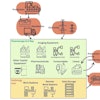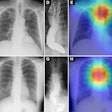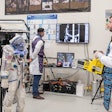VIENNA - The European Congress of Radiology traditionally isn’t known as a showcase for new product introductions -- most companies use the RSNA conference for that. But Dutch multimodality vendor Philips Medical Systems took advantage of this week’s ECR meeting to launch a new line of surgical C-arms, as well as a new desktop computed radiography system.
The C-arm family, called the BV line, ranges from an economy system to a high-end unit capable of advanced applications like contrast bolus chasing and cardiovascular imaging.
The entry-level system, BV Libra, was designed for routine surgical applications, especially orthopedics and urology. Libra has an x-ray tube with a fixed anode, but the system is capable of pulsed fluoroscopy, which reduces normal fluoro dose by half, according to the company. BV Libra also weighs 17% less than BV 25, the Philips entry-level C-arm that it is replacing.
BV Endura stands at the mid-range of the BV line. The system is capable of vascular imaging and supports larger image intensifiers than BV Libra, for larger field-of-views. Endura has a fixed anode like BV Libra, and replaces BV 300 in the company’s C-arm product line.
Philips established a new price point in its C-arm offerings with BV Pulsera. Unlike Libra or Endura, the new unit employs a rotating anode that enables the system to conduct all applications, including cardiovascular procedures and bolus chasing. Philips also emphasized Pulsera’s low-dose characteristics.
Philips has set the price range for the BV systems starting at 60,000 euros for an entry-level Libra, on up to as much as 150,000 euros for a fully configured Pulsera. In addition to European approvals, the BV systems have Food and Drug Administration clearances.
The other new Philips product at ECR is PCR Compano, a new entry-level desktop computed radiography system. The unit is designed for small hospitals and clinics that want to convert their x-ray systems to digital without the cost of a more expensive CR or digital radiography system, according to the company.
PCR Compano features a small footprint of 1 square meter, and has a throughput of 56-90 x-ray cassettes per hour, depending on cassette size. The system’s resolution is the equivalent of 400-speed film, and the product supports all x-ray applications except mammography.
Although Philips already markets a flat-panel digital radiography system, the company believes that CR has a bright future ahead. There are some 100,000 bucky systems installed around the world that would be appropriate for digital upgrades, but DR is not the best option for many of these units due to cost and versatility issues. Special projections and mobile imaging, for example, are most appropriate with CR rather than DR, Philips believes.
PCR Compano joins PCR 5000 and PCR 500 in the company’s CR line. All the systems were developed through the company’s relationship with Fujifilm Medical Systems (Compano is based on Fuji’s SmartCR unit, introduced at last year’s RSNA meeting). Philips has added its own user interface and post-processing algorithms to the system, according to the company. Compano carries a list price of about 60,000 euros and will begin shipping in the middle of 2001.
Philips’ ECR highlights went beyond just x-ray, however. The company provided a closer look at its multislice CT technology, first introduced at last year’s RSNA meeting. Called TrueView, Philips hopes the technique will enable the firm to leapfrog other companies that have been able to get multislice CT scanners on the market more quickly.
TrueView employs both cone-beam acquisition and reconstruction, which differs from other multislice scanners currently on the market, according to Philips. These systems deliver 3-D cone-shaped x-ray beams, but employ reconstruction techniques that are based on 2-D fan-beam technology. That’s fine for four-slice scanning, the current state of the art. But Philips claims that artifacts may result if these systems are upgraded to eight slices and above, as most multislice vendors are planning to do.
Philips also highlighted other aspects of TrueView, such as DoseRight, which automatically optimizes radiation dose based on the type of patient being scanned, and BeamRight, which corrects for the overbeaming found on some multislice systems, Philips said.
TrueView will be available as an upgrade to the company’s CT Secura premium system. The company expects that the technology will begin shipping in the second half of 2001.
By Brian Casey
AuntMinnie.com staff writer
March 6, 2001
Related Reading
Philips to enter multislice CT fray with Secura MV, November 30, 2000
Fuji to enter desktop CR market, November 26, 2000
Click here to post your comments about this story. Please include the headline of the article in your message.
Copyright © 2001 AuntMinnie.com



















